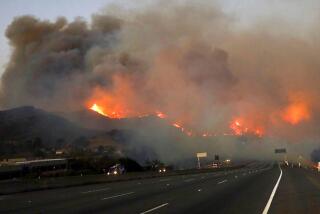Santa Paula Trustees to Decide Whether to Support Tax District
- Share via
Santa Paula residents could be taxed up to $50 a year to fix and maintain recreational fields and school buildings, including the city’s only public swimming pool, under a proposal that will come before high school trustees tonight.
If Santa Paula Union High School District trustees approve taking steps to form a tax district, it would be the first school board in Ventura County to pursue a little-known levying mechanism, said Tahir Ahad, the district’s business director.
Formation of the tax district does not require voter approval, Ahad said. That could have wider implications for Ventura County taxpayers who live in districts where the public uses aging gymnasiums and athletic facilities, county school officials said.
“If they can indeed do it, there are a lot of facilities and recreation areas that need that kind of financing,” said Charles Weis, the county’s superintendent of schools.
Weis said he was not aware that school boards could form such assessment districts. But Tahir said local boards have had that power since 1972, when the state Legislature enacted the Landscaping and Lighting Act.
Henry Heydt, spokesman for the state Department of Education, said only about a dozen school districts statewide have formed similar levying authorities. And although that power has been available to school boards for more than two decades, educators have only recently begun to take advantage of it.
Boards are combing state laws trying to find new ways to tap public dollars because state funding for public education has been hit hard by California’s recession, Heydt said.
“When money dries up, school administrators start looking anywhere they can for new funding,” he said.
Ahad said the levy is needed because the high school district does not have enough money to fix leaky gymnasium roofs, repair aging athletic fields and refurbish the swimming pool.
Those facilities are used not only by students, but by the community, Ahad said. The 1972 law allows local school boards to form assessment districts to maintain and operate recreational facilities used by the public, he said.
*
About 8,100 homeowners in Santa Paula and outlying areas would be included in the mandatory tax area, which school administrators call a maintenance assessment district.
The boundaries are the same as those for the high school district, Ahad said. They include all of incorporated Santa Paula, extending east and west of the city about four miles, and reaching north to eastern Ojai and south to South Mountain, Ahad said.
Trustees will vote tonight on whether to adopt a resolution stating their intent to form the assessment district, the first step toward its creation. The board will meet at 7 p.m. in the council chambers at City Hall.
Affected homeowners do not get to vote directly on the issue. But, Ahad noted, trustees could be held accountable at the next election. The public will have a chance to speak out on the levy at two public hearings scheduled in June, he said.
*
Trustees must hold the public hearings and approve a study that shows the need for the levy before they give final authorization for the district, Ahad said.
Educators decided to consider an assessment district because state funding for maintenance and operation of recreational facilities has shriveled over the past decade, Ahad said. Although the district is nearing completion of an $8-million, five-year campus improvement project, those monies can be used only for new construction, he said.
The high school district has been hit hard by budget cuts, Ahad said. And although the city’s recreation department relies heavily on the use of the district’s facilities, he said, city officials have not offered to help refurbish them.
So when it came down to closing the high school pool or imposing a levy, he said, administrators decided to go with the assessment district, he said.
The roof is leaking at one of the high school’s two gymnasiums, and there are ripped curtains and broken seats in an auditorium, Ahad said. And the district is so strapped that it doesn’t have $30,000 a year to keep the pool free of algae, he said.
If the district doesn’t find money to pay for the pool’s upkeep, it could be closed as soon as May and filled in, school officials have said.
If the assessment district is approved, it would be enacted July 1, Ahad said.
Homeowners would see the levy reflected in their property tax bills starting in December, he said.
More to Read
Sign up for Essential California
The most important California stories and recommendations in your inbox every morning.
You may occasionally receive promotional content from the Los Angeles Times.














